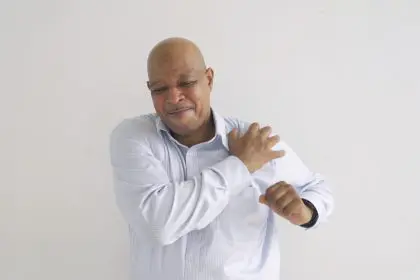A growing body of research points to this overlooked structure as the missing piece in back pain treatment
Back pain remains one of the most common health complaints worldwide, affecting an estimated 80% of adults at some point in their lives. Despite its prevalence, effective treatment often proves elusive, with many sufferers cycling through medications, surgeries, and various therapies without finding lasting relief. The explanation for this treatment gap may lie in a frequently overlooked muscle that plays a crucial role in spinal stability and function.
This overlooked muscular structure doesn’t capture attention like the more visible “six-pack” abdominals or the large back muscles that power obvious movements. Instead, it works quietly but fundamentally to maintain proper spinal alignment and movement patterns. When this muscle weakens or becomes dysfunctional, it sets off a cascade of compensations throughout the body that can manifest as persistent back pain resistant to conventional treatments.
Recent advances in movement science and rehabilitation have brought this muscle into sharper focus, revealing its critical importance for back health. Understanding its function and learning targeted strategies to restore its proper operation may offer hope to millions suffering from stubborn back pain that has failed to respond to standard interventions.
The transverse abdominis: your body’s natural back brace
The transverse abdominis (TVA) represents the deepest layer of abdominal muscles, wrapping horizontally around the torso like an internal corset. Unlike more superficial muscles designed for creating movement, the TVA’s primary function involves stabilization and pressure regulation within the core. When functioning optimally, it creates a firm foundation from which the spine and limbs can safely move.
This deep muscle attaches to the thoracolumbar fascia, a sheet of connective tissue spanning the lower back region. Through this connection, the TVA directly influences spinal stability. When it contracts properly, it increases tension in this fascia, effectively creating a supportive band around the lower spine segments where most pain occurs.
Research utilizing fine-wire electromyography has demonstrated that in individuals without back pain, the TVA activates milliseconds before limb movement. This anticipatory contraction creates a stable core from which motion can safely originate. However, in people with chronic back pain, this precise timing becomes disrupted. The TVA activates late or ineffectively, leaving the spine vulnerable during movement and increasing stress on passive structures like discs and ligaments.
Imaging studies comparing healthy subjects to those with recurrent back pain reveal significant differences in TVA thickness, activation patterns, and coordination with other core muscles. Those suffering from persistent pain typically show atrophy of this critical muscle, with reductions in size ranging from 22% to 38% compared to pain-free individuals. Perhaps more importantly, they demonstrate an inability to contract it independently from other abdominal muscles, creating inefficient movement patterns that perpetuate pain cycles.
The relationship between TVA dysfunction and back pain creates a problematic cycle. Pain inhibits proper muscle recruitment, leading to compensatory movement patterns that further stress the spine, creating more pain. Breaking this cycle requires specific interventions targeted at restoring proper function to this foundational muscle.
Why traditional core exercises often miss the mark
Despite the popularity of core strengthening for back pain, many traditional approaches fail to effectively target the TVA. Common exercises like crunches, sit-ups, and even planks often emphasize more superficial muscles while allowing the deep stabilizers to remain relatively passive. This explains why some individuals develop impressive-looking abdominals yet continue experiencing back pain.
The problem stems partly from how the TVA functions. Unlike muscles designed for creating visible movement, it works isometrically to create intra-abdominal pressure and spinal stability. Traditional exercises that focus on trunk flexion or extension movements can actually reinforce dysfunctional patterns if performed without proper TVA engagement.
Many fitness programs emphasize quantity over quality, prioritizing repetitions or duration rather than precise neuromuscular control. For rehabilitating the TVA, this approach proves counterproductive. Research indicates that just a few properly executed contractions can stimulate positive adaptations in this muscle, while dozens of repetitions with poor form may further ingrain problematic patterns.
Another issue involves the tendency to train core muscles in isolation rather than as an integrated system. The TVA works in coordination with the diaphragm, pelvic floor, and multifidus (a deep spinal muscle) to create three-dimensional stability. Exercises that fail to recognize these relationships often produce incomplete results.
Even well-intentioned physical therapy interventions sometimes miss crucial aspects of TVA rehabilitation. Traditional strengthening approaches may not address the timing and coordination deficits that characterize TVA dysfunction in back pain sufferers. Without restoring these neuromuscular control elements, simply building strength proves insufficient for lasting pain relief.
Reawakening your body’s natural support system
Effective TVA rehabilitation begins with developing awareness and control of this often dormant muscle. The initial focus centers on isolated activation before progressing to integrated function during daily activities and exercise.
The process typically starts with what rehabilitation specialists call “drawing in” the lower abdominal region. This subtle movement involves gently pulling the area below the navel toward the spine without overly tensing the visible abdominal muscles or altering breathing patterns. Many first-time attempts result in substitution patterns – holding the breath, pressing the abdominals outward, or contracting the rectus abdominis (six-pack muscle) instead.
Learning proper activation often requires specific feedback methods. Placing the fingers just inside the hip bones helps detect the subtle tension that indicates correct TVA engagement. Some rehabilitation programs utilize specialized pressure biofeedback units that measure changes in pressure when placed beneath the lower back, providing objective feedback about TVA activation.
The breathing-TVA connection proves crucial for rehabilitation success. The diaphragm and TVA function as synergists in creating intra-abdominal pressure. Proper breathing patterns – using the diaphragm rather than chest muscles – facilitate natural TVA activation. Many back pain sufferers demonstrate dysfunctional breathing patterns that compromise this relationship, necessitating concurrent breathing retraining during rehabilitation.
Once basic awareness develops, the focus shifts to maintaining TVA engagement during progressively more challenging activities. This progression follows a developmental sequence similar to how infants naturally develop core stability – beginning with supported positions before advancing to all fours, sitting, standing, and finally dynamic movements.
Throughout this process, quality of activation takes precedence over quantity or intensity. Research demonstrates that just 30% of maximum voluntary contraction provides optimal stabilization without creating excessive rigidity or compensations. This moderate level of engagement allows the TVA to fulfill its stabilizing role while permitting appropriate movement through the spine.
From isolation to integration: building a resilient system
After establishing basic TVA control, effective rehabilitation progresses to functional integration. This crucial phase transforms isolated contractions into automatic stabilization during daily activities – the ultimate goal for lasting pain relief.
This integration process addresses several key dimensions. Movement pattern retraining teaches individuals to maintain appropriate TVA engagement during activities that previously triggered pain. This often requires temporarily simplifying movements to focus on quality before gradually reintroducing complexity.
Postural retraining represents another critical component. Many back pain sufferers display habitual postures that inhibit proper TVA function. These include excessive anterior pelvic tilt, slouched sitting positions, and overextended standing alignments. Correcting these patterns while maintaining appropriate TVA activation creates the foundation for sustainable improvement.
Load management strategies prove essential during this integration phase. Many back pain episodes occur when attempting activities that exceed the current capacity of the stabilization system. Learning to appropriately scale activities based on stability requirements helps prevent setbacks and builds confidence in movement.
Sensory integration also plays a vital role in this process. The body relies on feedback from various sensory systems to coordinate appropriate muscle activation. Rehabilitation approaches that incorporate balance challenges, unstable surfaces, and varied environments help recalibrate these sensory-motor connections.
Throughout this progression, patience and consistency outweigh intensity. Research indicates that neuroplastic changes in muscle activation patterns typically require 4-6 weeks of consistent practice. This timeline often frustrates those seeking immediate relief, but understanding the biological processes involved helps set realistic expectations for recovery.
Beyond exercise: lifestyle factors affecting TVA function
While targeted exercise forms the cornerstone of TVA rehabilitation, several lifestyle factors significantly impact this muscle’s function and recovery potential.
Stress levels directly influence TVA performance through multiple pathways. Chronic stress alters breathing patterns, typically shifting toward shallow chest breathing that compromises the diaphragm-TVA relationship. Additionally, stress-induced muscle tension, particularly in the psoas muscle that connects the spine to the legs, can inhibit proper TVA activation. Incorporating stress management techniques like meditation or progressive relaxation often accelerates rehabilitation progress.
Sleep quality significantly affects muscle recovery and nervous system regulation. During deep sleep stages, the body performs crucial maintenance on muscle tissue and consolidates motor learning from rehabilitation exercises. Poor sleep compromises these processes, potentially negating daytime rehabilitation efforts. Creating sleep-supportive routines and environments constitutes an often-overlooked aspect of effective back pain treatment.
Hydration status influences fascial tissue health throughout the core region. The thoracolumbar fascia, which connects directly with the TVA, depends on adequate hydration for optimal flexibility and force transmission. Chronically dehydrated tissues become less pliable and more prone to irritation, potentially undermining TVA function despite appropriate exercise.
Nutritional factors also play a role in TVA rehabilitation. Chronic inflammation, often influenced by dietary choices, can alter muscle activation patterns and delay tissue recovery. Anti-inflammatory nutrition approaches emphasizing colorful produce, omega-3 fatty acids, and adequate protein intake support the tissue healing necessary for successful rehabilitation.
Movement variety throughout the day impacts TVA function beyond formal exercise sessions. Prolonged static postures, whether standing or sitting, create predictable patterns of muscle inhibition and overactivation. Incorporating position changes and movement breaks every 30 minutes helps maintain optimal neuromuscular patterns established during rehabilitation sessions.
When to seek specialized help for TVA dysfunction
While many TVA rehabilitation principles can be self-applied, certain situations warrant professional guidance to ensure appropriate intervention and avoid potential complications.
Acute or severe back pain episodes should receive proper medical evaluation before beginning any exercise program. While TVA dysfunction commonly contributes to chronic pain, acute episodes may involve additional factors requiring specific treatment approaches. Professional assessment helps determine when TVA-focused rehabilitation becomes appropriate within the recovery timeline.
Persistent difficulty feeling or activating the TVA despite following basic instructions suggests the need for personalized guidance. Some individuals require specific cueing approaches or feedback methods based on their unique movement patterns and body awareness. Skilled practitioners can identify substitution patterns that might otherwise go unnoticed and impede progress.
Cases involving significant fear of movement benefit from professionally guided rehabilitation. Pain-related fear often prevents effective engagement with necessary exercises, creating a barrier to recovery. Experienced practitioners can provide the reassurance and graduated exposure needed to overcome these psychological obstacles.
Situations involving multiple failed treatment attempts may indicate complicated presentations requiring comprehensive assessment. TVA dysfunction rarely exists in isolation, often occurring alongside other contributing factors that require integrated management. These might include hip mobility restrictions, thoracic spine stiffness, or pelvic floor dysfunction that influence TVA performance.
Those with specific medical conditions affecting core function, such as diastasis recti (abdominal separation) or hernias, need modified approaches to TVA rehabilitation. These conditions alter the mechanical environment in which the TVA operates, requiring specialized expertise to design appropriate interventions.
Maintaining TVA function for lifelong back health
Once proper TVA function has been established, attention shifts to maintenance strategies that prevent recurrence of dysfunction and associated pain. This maintenance phase focuses on sustainability and integration into normal life patterns rather than intensive rehabilitation.
Daily micro-practices prove more effective than occasional intensive sessions. Brief moments of TVA engagement throughout the day, particularly before challenging movements or during transitions between positions, help maintain the neuromuscular patterns established during rehabilitation. These “movement check-ins” require minimal time yet provide substantial protective benefits.
Varied movement experiences support ongoing TVA function. Different activities challenge the stabilization system in unique ways, developing adaptability that protects against future injury. Incorporating a mix of rotational movements, single-leg activities, and varied environments helps maintain comprehensive core function rather than specialized capacity in limited patterns.
Periodic reassessment prevents subtle regression to previous dysfunctional patterns. Simple self-checks, such as monitoring breathing patterns during stress or assessing TVA activation before rising from bed, help identify early signs of returning dysfunction before pain develops. These awareness practices serve as an early warning system for maintaining back health.
Balanced strength development across the entire core system supports optimal TVA function. While isolated rehabilitation initially emphasizes this specific muscle, long-term health depends on appropriate strength relationships between all core components. Comprehensive approaches that address the entire system while maintaining proper TVA integration provide the most sustainable results.
Perhaps most importantly, maintaining body awareness during changing life circumstances protects TVA function through various challenges. Periods of stress, illness, or changing activity demands can temporarily alter movement patterns. Recognizing these challenges and briefly revisiting foundational practices during such times prevents minor changes from developing into chronic dysfunction.
By understanding the crucial role of this often-neglected muscle and implementing appropriate strategies to restore and maintain its function, many chronic back pain sufferers can find the relief that has eluded them through conventional approaches. The path involves patience and precision rather than intensity, but the potential reward – freedom from persistent pain – makes this investment in foundational core health worthwhile.













